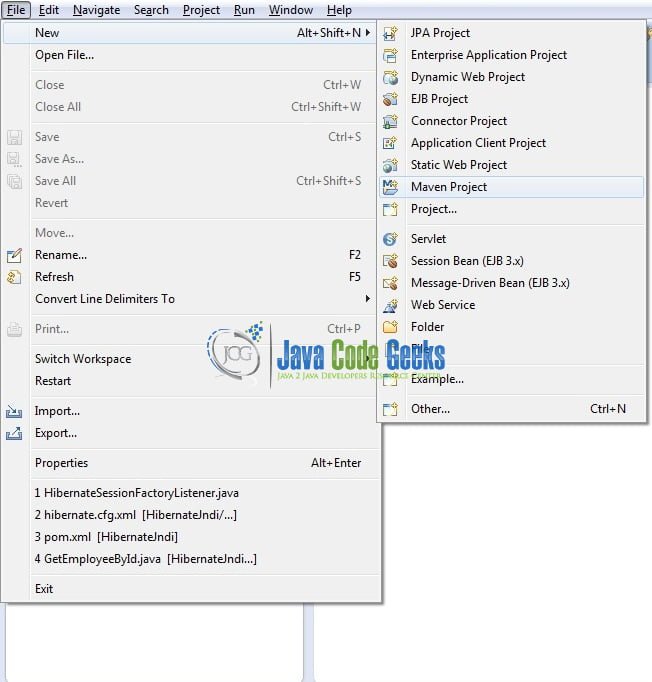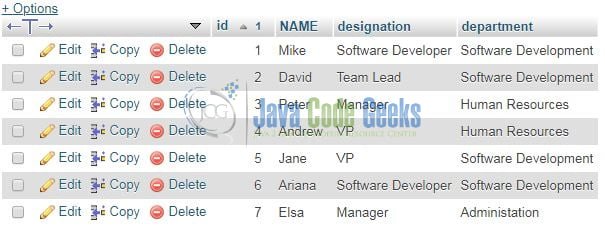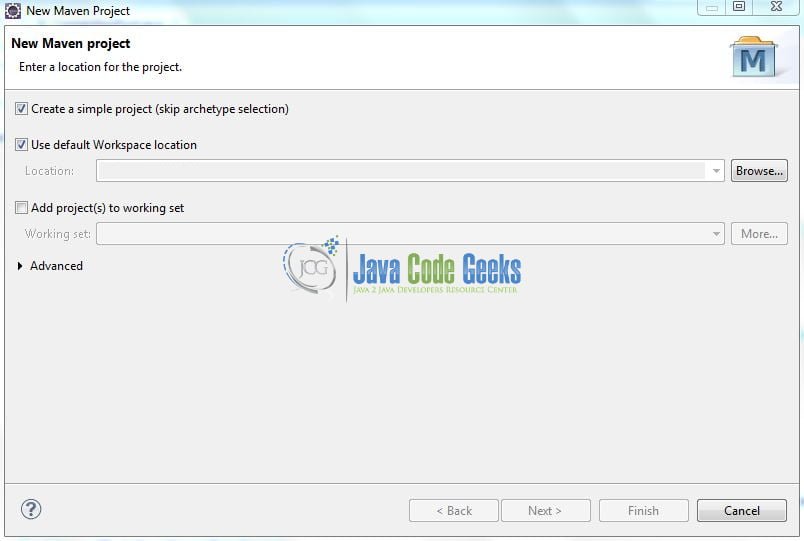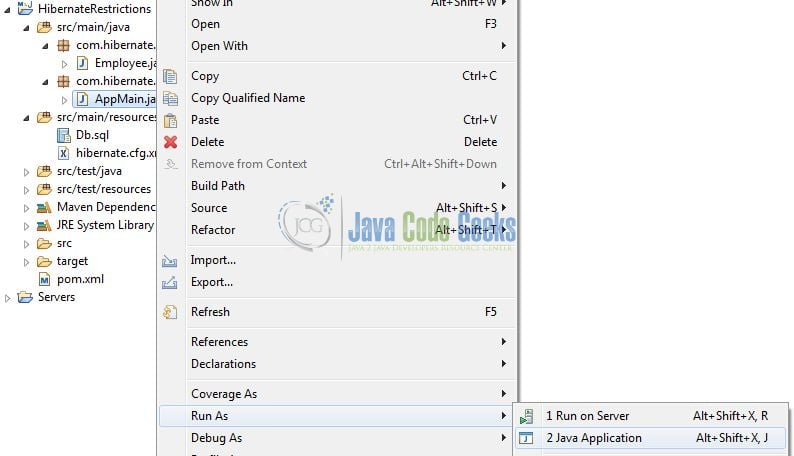Hibernate Criteria using Restrictions Example
In hibernate; developers can use the criteria query language to fetch the records from a relational database based on specific conditions. In this tutorial, we will explore the use of Restrictions with the Hibernate Criteria.
1. Introduction
- Object-Relational Mapping or ORM is the programming technique to map application domain model objects to the relational database tables
- Hibernate is a Java-based ORM tool that provides the framework for mapping application domain objects to the relational database tables and vice versa. It provides the reference implementation of Java Persistence API that makes it a great choice as an ORM tool with benefits of loose coupling
- A Framework that an option to map plain old Java objects to the traditional database tables with the use of JPA annotations as well as
XMLbased configuration
1.1 Hibernate Annotations
- Hibernate annotations are the newest way to define mappings without the use of a
XMLfile - Developers use annotations to provide metadata configuration along with the Java code. Thus, making the code easy to understand
- XML provides the ability to change the configuration without building the project. Thus, annotations are less powerful than the
XMLconfiguration and should only be used for table and column mappings - Annotations are preconfigured with sensible default values, which reduce the amount of coding required. For e.g., Class name defaults to Table name and Field names default to Column names
1.2 Hibernate Criteria
Hibernate Criteria Query language allow the developers to fetch the data from the relational database. The Criteria interface define several methods to specify the criteria and the object can be obtained by calling the createCriteria() method of the Session interface. The syntax for this method is.
public Criteria createCriteria(Class c)
The following points support the Criteria API in the Hibernate framework:
- Safe from SQL injection
- Supports pagination
- Promote easy and cleaner queries
- Helps compile-time checking
- Perform only select query operations
1.2.1 Using Restrictions with Hibernate Criteria
The Criteria interface makes it easy to selectively fetch the data on the basis of conditions in the select query. The Restriction class in hibernate provide several methods that can be used as conditions (also known as Criterion). These conditions are added to a criteria object with the add() method. This method takes an org.hibernate.criterion.Criterion object argument that represents the individual condition. Following snippet illustrate the use of restrictions in criteria.
Code Snippet
// creating the criteria object.
Criteria myCriteria = session.createCriteria(Sample.class);
// giving a specific condition in the select query to fetch the records.
Criterion nameCriteria = Restrictions.eq("topicname", "hibernate");
// adding the condition to the 'add()' method of the criteria object.
myCriteria.add(nameCriteria);
// fetching the particular records from the database.
List myList = myCriteria.list();
The commonly used methods of the Restriction class are as follows.
| Method | Description |
|---|---|
public static SimpleExpression lt(String propertyName,Object value) | Sets less than condition to the given property |
public static SimpleExpression le(String propertyName,Object value) | Sets less than or equal condition to the given property |
public static SimpleExpression gt(String propertyName,Object value) | Sets greater than condition to the given property |
public static SimpleExpression ge(String propertyName,Object value) | Sets greater than or equal condition to the given property |
public static SimpleExpression ne(String propertyName,Object value) | Sets not equal condition to the given property |
public static SimpleExpression eq(String propertyName, Object value) | Sets the equal condition to the given property |
public static SimpleExpression like(String propertyName, Object value) | Sets the like condition to the given property |
public static Criterion between(String propertyName, Object low, Object high) | Sets the between constraint |
1.3 Download and Install Hibernate
You can read this tutorial in order to download and install Hibernate in the Eclipse IDE.
1.4 Download and Install MySQL
You can watch this video in order to download and install the MySQL database on your Windows operating system.
Now, open up the Eclipse IDE and let us see how to implement this method in the hibernate framework!
2. Hibernate Criteria using Restrictions Example
Here is a systematic guide for implementing this tutorial in the hibernate framework.
2.1 Tools Used
We are using Eclipse Kepler SR2, JDK 8, MySQL database and Maven. Having said that, we have tested the code against JDK 1.7 and it works well.
2.2 Project Structure
Firstly, let us review the final project structure, in case you are confused about where you should create the corresponding files or folder later!

2.3 Project Creation
This section will demonstrate how to create a Java-based Maven project with Eclipse. In Eclipse IDE, go to File -> New -> Maven Project.

In the New Maven Project window, it will ask you to select the project location. By default, ‘Use default workspace location’ will be selected. Select the ‘Create a simple project (skip archetype selection)’ checkbox and just click on the next button to proceed.
It will ask you to ‘Enter the group and the artifact id for the project’. We will input the details as shown in the below image. The version number will be by default: 0.0.1-SNAPSHOT.
Click on Finish and the creation of a maven project is completed. If you observe, it has downloaded the maven dependencies and a pom.xml file will be created. It will have the following code:
pom.xml
<project xmlns="http://maven.apache.org/POM/4.0.0" xmlns:xsi="http://www.w3.org/2001/XMLSchema-instance" xsi:schemaLocation="http://maven.apache.org/POM/4.0.0 http://maven.apache.org/xsd/maven-4.0.0.xsd"> <modelVersion>4.0.0</modelVersion> <groupId>com.hibernate</groupId> <artifactId>HibernateRestrictions</artifactId> <version>0.0.1-SNAPSHOT</version> <name>Hibernate Criteria Restrictions Example</name> <packaging>jar</packaging> </project>
We can start adding the dependencies that developers want like Hibernate, MySQL etc. Let us start building the application!
3. Application Building
Below are the steps involved in developing this application.
3.1 Database and Table Creation
The following script creates a database called restrictiondb with a table: employee. Open MySQL terminal and execute the script.
CREATE DATABASE IF NOT EXISTS restrictiondb; USE restrictiondb; CREATE TABLE employee ( id INT(50) NOT NULL AUTO_INCREMENT, name VARCHAR(200) DEFAULT NULL, designation VARCHAR(200) DEFAULT NULL, department VARCHAR(200) DEFAULT NULL, PRIMARY KEY (id) ); INSERT INTO employee (id, name, designation, department) VALUES (1, 'Mike', 'Software Developer', 'Software Development'); INSERT INTO employee (id, name, designation, department) VALUES (2, 'David', 'Team Lead', 'Software Development'); INSERT INTO employee (id, name, designation, department) VALUES (3, 'Peter', 'Manager', 'Human Resources'); INSERT INTO employee (id, name, designation, department) VALUES (4, 'Andrew', 'VP', 'Human Resources'); INSERT INTO employee (id, name, designation, department) VALUES (5, 'Jane', 'VP', 'Software Development'); INSERT INTO employee (id, name, designation, department) VALUES (6, 'Ariana', 'Software Developer', 'Software Development'); INSERT INTO employee (id, name, designation, department) VALUES (7, 'Elsa', 'Manager', 'Administation');
If everything goes well, the table will be created.

3.2 Maven Dependencies
Here, we specify the dependencies for the Hibernate framework and the MySQL connector. Maven will automatically resolve the rest dependencies such as Hibernate Core, MySQL etc. The updated file will have the following code:
pom.xml
<project xmlns="http://maven.apache.org/POM/4.0.0" xmlns:xsi="http://www.w3.org/2001/XMLSchema-instance" xsi:schemaLocation="http://maven.apache.org/POM/4.0.0 http://maven.apache.org/xsd/maven-4.0.0.xsd">
<modelVersion>4.0.0</modelVersion>
<groupId>com.hibernate</groupId>
<artifactId>HibernateRestrictions</artifactId>
<version>0.0.1-SNAPSHOT</version>
<name>Hibernate Criteria Restrictions Example</name>
<packaging>jar</packaging>
<dependencies>
<!-- https://mvnrepository.com/artifact/org.hibernate/hibernate-core -->
<dependency>
<groupId>org.hibernate</groupId>
<artifactId>hibernate-core</artifactId>
<version>5.3.7.Final</version>
</dependency>
<!-- https://mvnrepository.com/artifact/mysql/mysql-connector-java -->
<dependency>
<groupId>mysql</groupId>
<artifactId>mysql-connector-java</artifactId>
<version>8.0.13</version>
</dependency>
</dependencies>
<build>
<finalName>${project.artifactId}</finalName>
</build>
</project>
3.3 Java Class Creation
Let us write the Java classes involved in this application.
3.3.1 Implementation of Model Class
Add the following code to the model definition to map the attributes with the column names.
Employee.java
package com.hibernate.model;
import java.util.List;
import javax.persistence.Entity;
import javax.persistence.GeneratedValue;
import javax.persistence.GenerationType;
import javax.persistence.Id;
import javax.persistence.Table;
@Entity
@Table(name= "employee")
public class Employee {
@Id
@GeneratedValue(strategy= GenerationType.IDENTITY)
private int id;
private String name;
private String designation;
private String department;
public int getId() {
return id;
}
public void setId(int id) {
this.id = id;
}
public String getName() {
return name;
}
public void setName(String name) {
this.name = name;
}
public String getDesignation() {
return designation;
}
public void setDesignation(String designation) {
this.designation = designation;
}
public String getDepartment() {
return department;
}
public void setDepartment(String department) {
this.department = department;
}
// Method to display the db result.
// Used lambda expression technique of jdk1.8 to display the result list.
public void show(List elist) {
elist.forEach((e) -> {
System.out.println("Employee [id=" + e.getId() + ", name=" + e.getName() + ", designation=" + e.getDesignation() + ", department=" + e.getDepartment() + "]");
});
}
}
3.3.2 Implementation of Utility Class
Add the following code to the implementation class for testing the Restrictions in the Hibernate Criteria.
AppMain.java
package com.hibernate.util;
import java.util.List;
import org.hibernate.Criteria;
import org.hibernate.Session;
import org.hibernate.cfg.Configuration;
import org.hibernate.criterion.Restrictions;
import com.hibernate.model.Employee;
public class AppMain {
@SuppressWarnings({ "deprecation", "unchecked" })
public static void main(String[] args) {
Employee emp = new Employee();
// Creating the config instance & passing the hibernate config file.
Configuration config = new Configuration();
config.configure("hibernate.cfg.xml");
// Session object in hibernate to start the db transaction.
Session s = config.buildSessionFactory().openSession();
// Criteria object in hibernate.
Criteria c1 = s.createCriteria(Employee.class);
// Restrictions api - Query 1.
c1.add(Restrictions.eq("designation", "Manager"));
List list1 = c1.list();
emp.show(list1);
System.out.println("\n===================\n");
// Restrictions api - Query 2.
Criteria c2 = s.createCriteria(Employee.class);
c2.add(Restrictions.between("id", 3, 5));
List list2 = c2.list();
emp.show(list2);
System.out.println("\n===================\n");
// Restrictions api - Query 3.
Criteria c3 = s.createCriteria(Employee.class);
/**** Note: A similar query for 'Restrictions.and(. . . .)' method has to be made !! ****/
c3.add(Restrictions.or(Restrictions.eq("designation", "VP"), Restrictions.eq("designation", "Software Developer")));
List list3 = c3.list();
emp.show(list3);
System.out.println("\n===================\n");
// Restrictions api - Query 4.
Criteria c4 = s.createCriteria(Employee.class);
c4.add(Restrictions.like("name", "A%"));
List list4 = c4.list();
emp.show(list4);
// Closing the session object.
s.close();
}
}
3.4. Hibernate Configuration File
In the configuration file, we will include the database and the mapping class details.
hibernate.cfg.xml
<?xml version="1.0" encoding="UTF-8"?> <!DOCTYPE hibernate-configuration PUBLIC "-//Hibernate/Hibernate Configuration DTD 3.0//EN" "http://www.hibernate.org/dtd/hibernate-configuration-3.0.dtd"> <hibernate-configuration> <session-factory> <!-- Database connection settings. --> <property name="hibernate.connection.driver_class">com.mysql.cj.jdbc.Driver</property> <property name="hibernate.connection.url">jdbc:mysql://localhost:3306/restrictiondb</property> <property name="hibernate.connection.username">root</property> <property name="hibernate.connection.password" /> <!-- Sql dialect. --> <property name="hibernate.dialect">org.hibernate.dialect.MySQLDialect</property> <!-- Printing the sql queries to the console. --> <property name="show_sql">true</property> <!-- Validating the database schema. --> <property name="hbm2ddl.auto">validate</property> <!-- Model class. --> <mapping class="com.hibernate.model.Employee" /> </session-factory> </hibernate-configuration>
Important points:
- Here, we instructed Hibernate to connect to a MySQL database named
restrictiondband the mapping class to be loaded - We have also instructed the Hibernate framework to use
MySQLDialecti.e. Hibernate will optimize the generated SQL statements for MySQL - This configuration will be used to create a hibernate
SessionFactoryobject show_sqltag will instruct the hibernate framework to log all the SQL statements on the console
4. Run the Application
To run the Hibernate application, Right-click on the AppMain class -> Run As -> Java Application. Developers can debug the example and see what happens after every step!
5. Project Demo
The code shows the following logs as the output of this tutorial.
Nov 08, 2018 12:07:26 AM org.hibernate.internal.SessionImpl createCriteria WARN: HHH90000022: Hibernate's legacy org.hibernate.Criteria API is deprecated; use the JPA javax.persistence.criteria.CriteriaQuery instead Hibernate: select this_.id as id1_0_0_, this_.department as departme2_0_0_, this_.designation as designat3_0_0_, this_.name as name4_0_0_ from employee this_ where this_.designation=? Employee [id=3, name=Peter, designation=Manager, department=Human Resources] Employee [id=7, name=Elsa, designation=Manager, department=Administation] =================== Nov 08, 2018 12:07:26 AM org.hibernate.internal.SessionImpl createCriteria WARN: HHH90000022: Hibernate's legacy org.hibernate.Criteria API is deprecated; use the JPA javax.persistence.criteria.CriteriaQuery instead Hibernate: select this_.id as id1_0_0_, this_.department as departme2_0_0_, this_.designation as designat3_0_0_, this_.name as name4_0_0_ from employee this_ where this_.id between ? and ? Employee [id=3, name=Peter, designation=Manager, department=Human Resources] Employee [id=4, name=Andrew, designation=VP, department=Human Resources] Employee [id=5, name=Jane, designation=VP, department=Software Development] =================== Hibernate: select this_.id as id1_0_0_, this_.department as departme2_0_0_, this_.designation as designat3_0_0_, this_.name as name4_0_0_ from employee this_ where (this_.designation=? or this_.designation=?) Nov 08, 2018 12:07:26 AM org.hibernate.internal.SessionImpl createCriteria WARN: HHH90000022: Hibernate's legacy org.hibernate.Criteria API is deprecated; use the JPA javax.persistence.criteria.CriteriaQuery instead Employee [id=1, name=Mike, designation=Software Developer, department=Software Development] Employee [id=4, name=Andrew, designation=VP, department=Human Resources] Employee [id=5, name=Jane, designation=VP, department=Software Development] Employee [id=6, name=Ariana, designation=Software Developer, department=Software Development] =================== Nov 08, 2018 12:07:26 AM org.hibernate.internal.SessionImpl createCriteria WARN: HHH90000022: Hibernate's legacy org.hibernate.Criteria API is deprecated; use the JPA javax.persistence.criteria.CriteriaQuery instead Hibernate: select this_.id as id1_0_0_, this_.department as departme2_0_0_, this_.designation as designat3_0_0_, this_.name as name4_0_0_ from employee this_ where this_.name like ? Employee [id=4, name=Andrew, designation=VP, department=Human Resources] Employee [id=6, name=Ariana, designation=Software Developer, department=Software Development]
That is all for this tutorial and I hope the article served you whatever you were looking for. Happy Learning and do not forget to share!
6. Conclusion
This post defines the implementation of the Restrictions class in the Hibernate Criteria and helps developers understand the basic configuration required to achieve this. Developers can download the sample application as an Eclipse project in the Downloads section.
7. Download the Eclipse Project
This was an example of the Hibernate Criteria with Restrictions for beginners.
You can download the full source code of this example here: HibernateRestrictions







